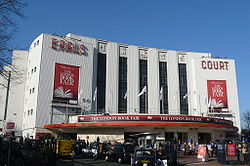Earls Court One (1991–2014) | |
 Earls Court Exhibition Centre in 2008 | |
 | |
| Location | Kensington, Fulham, London, SW5 United Kingdom |
|---|---|
| Coordinates | 51°29′20″N 0°11′52″W / 51.48889°N 0.19778°W |
| Public transit | |
| Owner | TfL, APG and Delancey |
| Capacity | 20,000 |
| Surface | Versatile |
| Construction | |
| Built | 1935–37 |
| Opened | 1 September 1937 |
| Expanded | EC II in 1991 |
| Closed | 13 December 2014 |
| Demolished | 2014–2016 |
| Construction cost | £1.5 million (£132 million in 2024 pounds[1]) |
| Architect | C. Howard Crane |
Earls Court Exhibition Centre was a major international exhibition and events venue in London, England. At its peak it is said to have generated a £2 billion turnover for the economy. It replaced exhibition and entertainment grounds, originally opened in 1887, with an art moderne structure built between 1935 and 1937 by specialist American architect C. Howard Crane. With the active support of London mayor Boris Johnson, in an attempt to create Europe's "largest regeneration scheme", its proposed heritage listing was refused after it was acquired by developers, who promptly in 2008 applied for and were granted a Certificate of Immunity from Listing by English Heritage, and its demolition was completed in 2017.[2]
Located in Earl's Court but straddling the boundary between the Royal Borough of Kensington and Chelsea and the Borough of Hammersmith and Fulham, it was the largest such venue within the capital served by two London Underground stations—one of them, Earl's Court tube station, being specially adapted with a tunnel for show visitors, and in latter years with a direct link to Heathrow Airport. The founder of the entertainment grounds was the Leeds entrepreneur John R. Whitley and the first attraction headlined performances by Buffalo Bill Cody as part of the American Show visited by Queen Victoria and subsequently by members of the Royal Household.[3] This was followed by numerous other exhibitions representing countries such as Canada, France and India.
Earls Court was widely known for serving as London's and the country's premier exhibition venue for many decades, hosting the Royal Smithfield Show, Royal Tournament, the British International Motor Show, London Boat Show, the Ideal Home Show, Billy Graham rallies, the Brit Awards (until 2010), Crufts and other events such as large scale opera productions and pop concerts in addition to hundreds of trade shows, such as the London Book Fair.[4] It was also used as one of the venues for both the 1948 and 2012 Olympic Games.
- ^ UK Retail Price Index inflation figures are based on data from Clark, Gregory (2017). "The Annual RPI and Average Earnings for Britain, 1209 to Present (New Series)". MeasuringWorth. Retrieved 7 May 2024.
- ^ Hill, Dave (21 November 2013). "Earls Court: Boris Johnson's borough chums sell lump of London cheap". The Guardian. Retrieved 18 May 2019.
- ^ Charles Lowe (1892). Four National Exhibitions in London and their Organiser. London: T. Fisher Unwin. Retrieved 11 October 2019.
- ^ Glanfield John (30 March 2003). Earls Court and Olympia: From Buffalo Bill to the Brits. Sutton Publishing Ltd. ISBN 978-0750929981.